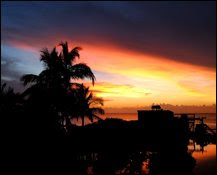The feeding ecology of corals of the Florida Reef Tract
Co-PIs Dr. Diego Lirman (
University of Miami) and Dr. Mark Teece (State University of New York) were at the Keys Marine Lab during the first week of June 2008, conducting research on the feeding ecology of corals of the Florida Reef Tract. The goals of this project, funded by the Mote Marine Laboratory “Protect Our Reefs” License Plate Grant Funding, are to document: (1) the relative contribution of autotrophic and heterotrophic sources of nutrition and the nutritional status of corals under different environmental conditions; and (2) the role of nutritional sources and status on coral growth and survivorship.

To accomplish these research goals the researchers will use a combination of field collections, field transplants, microcosm experiments, and the application of novel molecular-level biochemical and stable isotopic techniques to determine the relative importance of heterotrophic feeding versus autotrophically-derived organic matter in satisfying the nutritional requirements of the coral host. The results of this study will provide important insights into how corals may be able to adapt to declines in water quality associated with increasing coastal development and environmental change, and will therefore have direct implications for the conservation of corals in Florida and elsewhere.
Recent research has clearly shown that the vulnerability of corals to disturbance can be influenced by their energetic status and that the lipid reserves stored by corals may allow them to increase their resistance and resilience to stress. Moreover, the ability of corals to switch their main feeding mode, from autotrophy to heterotrophy, under marginal conditions marginal (i.e., high turbidity, sedimentation, high nutrients) can provide an adaptive mechanism for sustained growth over the short-term that may be fundamental to corals exposed to multiple stressors. The increased availability of heterotrophic energy and nutrient sources in nearshore coastal habitats has already been linked to higher coral growth, increased energy storage, and increased resilience to disturbances such as coral bleaching. These findings have led to the hypothesis that inshore habitats in the Florida Keys may provide an expanded heterotrophic niche for corals not available to offshore corals that will be tested in the proposed project using molecular-level biochemical and stable isotopic techniques.
 With logistic support provided by KML’s science staff, Lirman and Teece completed coral collections at 4 reefs in the Middle Florida Keys. At each reef (2 inshore and 2 offshore reefs), small (2-4 cm2) tissue shavings were collected from 2 abundant coral species, Porites astreoides and Montastraea faveolata, using a wood chisel. Some of the samples were kept for isotopic analyses and the remaining coral chips were used for a reciprocal transplant experiment established between inshore and offshore coral reefs. In addition to the coral tissue, researchers collected water, macroalgae, zooplankton, and sediment samples to analyze the isotopic composition of benthic primary producers and potential coral food sources. All samples were initially processed at the lab facilities provided by the Keys Marine Lab at Long Key, Florida.
With logistic support provided by KML’s science staff, Lirman and Teece completed coral collections at 4 reefs in the Middle Florida Keys. At each reef (2 inshore and 2 offshore reefs), small (2-4 cm2) tissue shavings were collected from 2 abundant coral species, Porites astreoides and Montastraea faveolata, using a wood chisel. Some of the samples were kept for isotopic analyses and the remaining coral chips were used for a reciprocal transplant experiment established between inshore and offshore coral reefs. In addition to the coral tissue, researchers collected water, macroalgae, zooplankton, and sediment samples to analyze the isotopic composition of benthic primary producers and potential coral food sources. All samples were initially processed at the lab facilities provided by the Keys Marine Lab at Long Key, Florida.
In June, 2008, reciprocal coral transplants were performed using tissue chips from colonies from inshore and offshore habitats to document changes in nutritional sources and lipid and protein storage as corals are transplanted to different habitats, and to evaluate the role of nutritional sources and reserves on coral growth and survivorship. Coral chips were glued to terracotta tiles and placed on PVC platforms at Coral Gardens (inshore site) and 11-ft Mound (offshore sites). The growth and survivorship of the transplants will be monitored at bi-monthly intervals, and a subset of transplanted coral chips will be collected after 2, 4, and 6 months for isotopic and lipid analysis.
For information on this project, please contact D. Lirman (dlirman@rsmas.miami.edu) or M. Teece (mteece@esf.edu).






